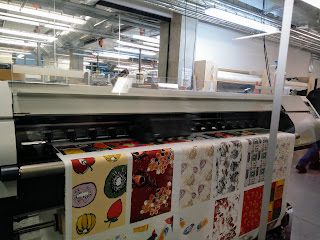For this project I have decided to create two complimentary
but distinct collections, one of which stems from my research into Markets and
Fruit and Veg and is very abstract, the other more commercial and inspired by
florals.
Ove the Easter holidays, I made the most of the equipment
available to me outside uni, and made up the table runners for my Market
collection, along with samples for napkins and placemats. To back the table
runners, I used a mid-weight cotton, which I dyed. For one of the runners, I dyed
the fabric green using direct dye in the dye baths in uni, and for the other I naturally
dyed it using turmeric. Of the two, I think the direct dye produced a more even
and overall deeper colour. However, I quite like the slightly patchy effect of
the turmeric, as it gives a distinctly hand-made feel to the piece. If I were
making these runners to sell, I think I would have to go for the direct dye as
my method of dying, as it gives a more consistent colour, but the natural dying
emphasises the one-off nature of the product, which I want to come through with
this collection. Therefore doing it both ways shows the potential of both
methods.
 |
| Turmeric dyed fabric drying. |
 |
| Backing the table runners. |
Along with the runners, I made examples of a napkin and
placemat. At first I planned for them both to be napkins, however I realised
that the fabric I had used was slightly too think to really be used for
napkins, and thus hemmed one of the samples by double folding the edges, and
the other I back using some of the dyed green cotton. I will continue to
develop these samples by trying them in thinner materials and perhaps by
digitally printing some designs.
 |
| Finished runners, napkin and placemat. |
As well as this I have continued to work on visualisations
of my designs on tableware. To take this further I will be taking photos of my
own crockery and using them to make visualisations which I then plan to make
into a publication along with styling photos of the table runners.
 |
| Photographing and visualising my table linen. |
long with the table runners, I began work on the floral
collection within this project. In order to connect both collections, I chose
to work from floral imagery by collaging, as I did with my research from the
markets. I particularly enjoy this method, as I like artwork that is tactile
and almost three-dimensional. To create some of the shapes and painterly
effects in my collage, I used a gelli plate to create stencilled designs, which
worked with layers of paint and paper. I loved this way of working as it is
very quick to cut out shapes and create a print, which can then be cut up and
used with other prints to create layered designs. When looking at the collages
made with the gelli printed paper alongside the plain coloured paper, they can
seem somewhat overworked, however I think by being considerate with the composition
and combining the two types of paper the collages can become really dynamic.
 |
| Floral imagery and inspiration. |
 |
| Gelli printing. |
ollowing this, I scanned in the collages and began to make
digital designs to be screen printed on top of and digitally printed. I found
this process quite challenging, as I am more accustomed to making digital designs
with geometric shapes rather than organic ones, however I am relatively please
with the outcomes and have had two lengths digitally printed to make into table
runners, complimentary to the market/abstract ones.
Following my tutorial in the first week back, I have been
planning what I’m going to make for assessment and the degree show. For the
degree show I aim to make tow one-off screen printed pieces, which I will have
stretched on frames and hung on a board. These will be flocked and embellished with
Perspex. This week I have been experimenting with transfer printing onto Perspex.
This works well, however I need to work out what the optimum time for keeping
the Perspex under the heat for it, to get maximum colour transfer and minimal
warping of the plastic from the heat.
 |
| Transfer printing onto Perspex. |
Next week I will be mostly in the print room, making my
screen prints for the degree show, as well as testing out different fabrics
such as sheer cottons and synthetics for the table linen collections. Additionally,
I will be making a repeat screen for one of my floral runners to flock onto it
and dying and backing my floral runners.




















Comments
Post a Comment